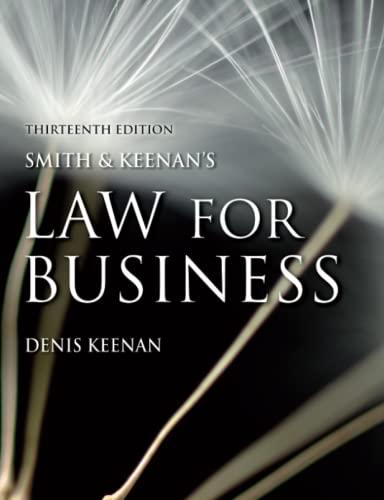Question
1 Reducing workplace injury, deterring poor performance, and reducing employers' legal and financial liability are reasons employers ues A- ineligibility testing B-eligibility testing C-nepotism D-word-of-mouth
- Reducing workplace injury, deterring poor performance, and reducing employers' legal and financial liability are reasons employers ues
A- ineligibility testing
B-eligibility testing
C-nepotism
D-word-of-mouth recruiting
10 points
QUESTION 2- A workplace substance abuse program should incorporate:
-a written abuse policy that has been drafted after input from employees.
-an employee education and awareness program.
-a supervisory training program.
-all of the above.
10 points
QUESTION 3- To avoid liability for negligent hiring, an employer must
-conduct a reasonable background check that would disclose information sufficient to determine whether the applicant is fit for the job.
-check the applicant's references.
-verify the information provided by the applicant on the application.
-All of the choices are correct.
10 points
QUESTION 4- Affirmative action is used:
-when there is a need to address past employment discrimination.
-when employers, private or public, are motivated to achieve racial balance in the workplace.
-when there is a demonstrated under representation or a finding of discrimination.
-All of the above.
10 points
QUESTION 5- Reverse discrimination:
-has never been acknowledged by the courts as a valid claim.
-occurs when a lawsuit is brought by a majority member claiming that he/she is a member of a protected class.
-occurs when a lawsuit is brought by a majority member claiming that he/she has been adversely affected by the use of an affirmative action plan.
-None of the above.
10 points
QUESTION 6- Title VII's ban on racial discrimination
-applies to black people only
-applies to black and Hispanic people only
-applies to all citizens equally
-applies only to people from another country
10 points
QUESTION 7- An employer will be found liable for racial harassment if the employee can show
-that the harassment was unwelcome and based on race
-that the harassment was so severe or pervasive that it altered the conditions of employment and created an abusive environment
-there is a basis for imposing liability on the employer
-All of the choices are correct.
10 points
QUESTION 8- EEOC guidelines state that employers can avoid liability for national origin discrimination after implementing an "English-only" rule if the employer can show that it is necessary:
-for communication with customers who only speak English.
-to promote efficiency for cooperative work assignments.
-to promote safety in an emergency.
-All of the choices are correct.
10 points
QUESTION 9- The Immigration Reform and Control Act (IRCA) makes it illegal to
-hire authorized aliens or refer authorized aliens for employment.
-discriminate in favor of American citizens if there is an equally qualified authorized alien.
-continue to employ an alien in the U.S. knowing that he/she has become an unauthorized alien.
-to hire an unauthorized alien if the employer is a federal contractor.
10 points
QUESTION 10- A claimant must prove discriminatory intent in order to be successful with a claim of national origin discrimination under:
-Title VII.
-IRCA.
-42 U.S.C. sec. 1981.
-FLSA.
Step by Step Solution
There are 3 Steps involved in it
Step: 1

Get Instant Access to Expert-Tailored Solutions
See step-by-step solutions with expert insights and AI powered tools for academic success
Step: 2

Step: 3

Ace Your Homework with AI
Get the answers you need in no time with our AI-driven, step-by-step assistance
Get Started


